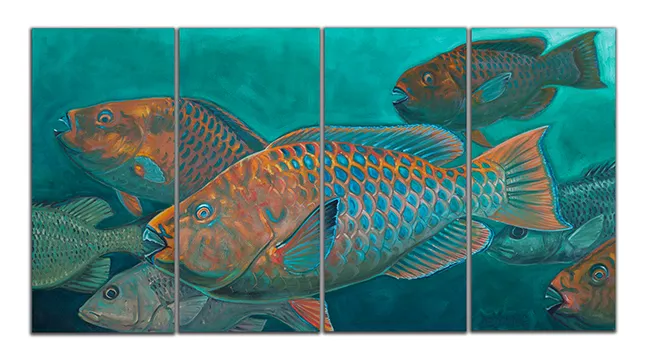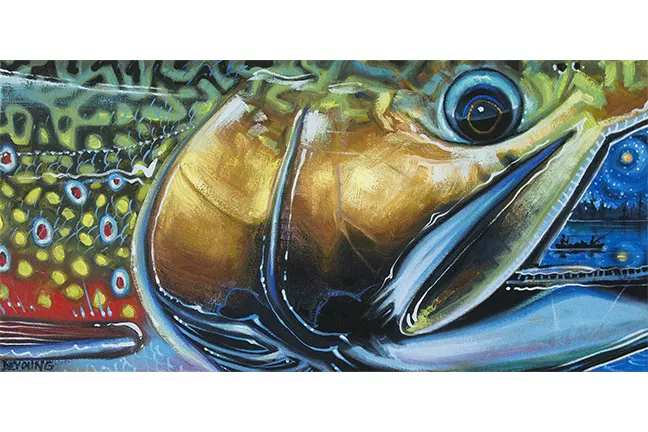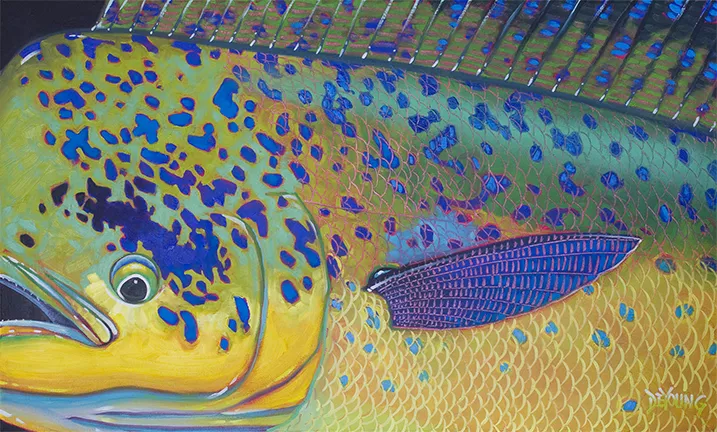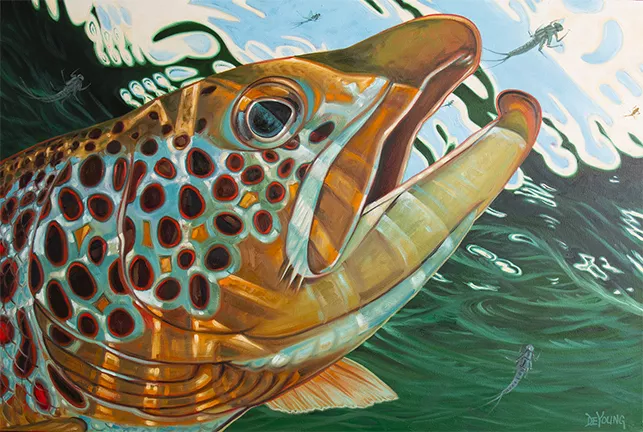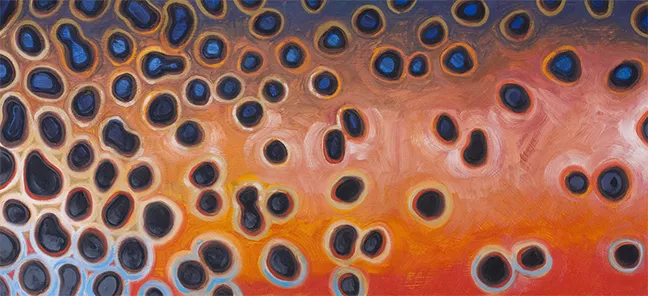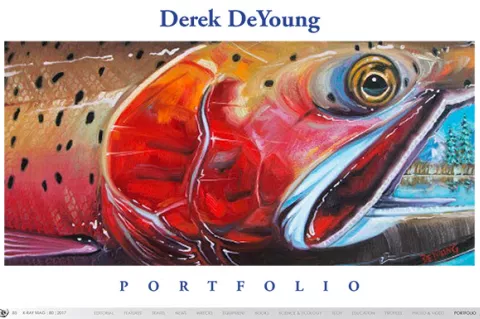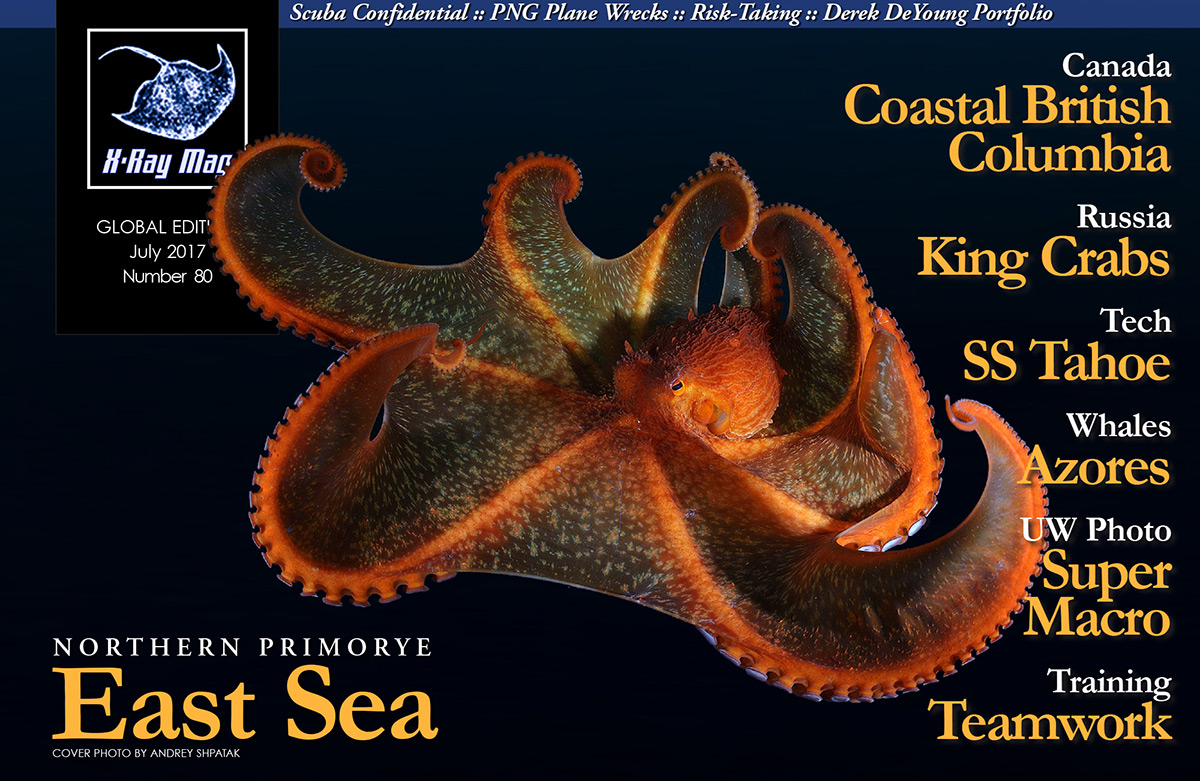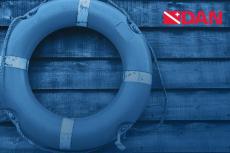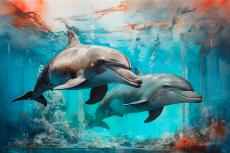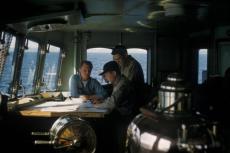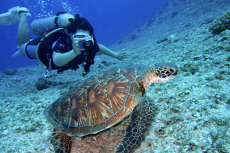American artist Derek DeYoung creates unique and spell-binding paintings of fresh and saltwater fish, which spur viewers to see and appreciate marine life in a different way. X-Ray Mag interviewed the artist to find out more about his work and his perspectives.
Contributed by
X-RAY MAG: Tell us about yourself, your background and how you became an artist.
DD: I am the youngest of three boys, and we were just incredibly competitive with each other. Growing up, right at the get-go, I was the artist of the three. My middle brother did minor in art in college, but it was one of those things, where he had too many other opportunities. He was such a smart kid, he was going to go into the business world. But for me, from a really early age, probably before I was six years old, everybody knew that I was going to be an artist when I grew up. And I think there was even a little too much optimism in that regard, because we all thought I was going to be an extremely famous artist. So (laughing) I bought into that early on and totally believed that it was going to happen.
I grew up in West Michigan on a small bayou just up river from Lake Michigan. Lake Michigan was my ocean. We spent every spare second just exploring the water, and wading around in the shallows. In the spring, there would be little baby northern pike, minnows, bluegills... We were just amazed with that, and I laugh because every effort in my life since then, and as an adult, has been, in a big way, to put me on the water as often as possible. And I really attribute it to that time when I was such a young boy and knee-deep in the water everyday. I just can’t even imagine a quality of life that wasn’t spent on the water.
X-RAY MAG: Why fish? How did you come to this theme?
DD: As a kid, my focus was a little less organized, but one of the things that I constantly drew was fish. I come from a family of fishermen, going generations back—not in a commercial sense, but a lot of the people in my family subsidized the meat that they ate during the year by fishing. They hunted deer in the fall. They hunted ducks and they fished, and I would say some of them didn’t buy any meat at all from the grocery store. So I was influenced by that but with the sensitive artist soul, I tend to be much more catch-and-release oriented.
X-RAY MAG: What is your creative process? How do you create your artwork?
DD: Well, it sounds cliché, but I would say the bulk of it is mental. And then through practice, through years of honing my craft, I can turn that mental process into an actual, physical piece of art. But to this day, my process starts if I’m sitting out on the water, or if I am sitting in an airplane seat at 30,000ft, or if I am laying in bed and can’t sleep—all these times, I let my mind start working on my next painting. And by the time I have kind of moved through it—step by step—I’ve got it both drawn and the palette worked out; I’ve got the style in which the paint will be applied worked out. As quickly as I can, I’ll get to my sketch book, and I’ll actually do a sketch of my ideas, and I will write notes next to them with my thoughts on the palette, which is the colors I will be using.
The overall goal in my entire body of work, and my entire reason for doing art in my life, is that I believe my gift in art is to conceptualize and think of things that have not been done before. To me, there is no greater thrill in art than to lead people to see something in a new way, and to get that little bit of a rise out of them, like, “Oh, my gosh! This is cool!” Many people have said to me—those that have no background in fishing and no background in looking at fish or diving—that they’ve never really looked at a fish before seeing my paintings.
I often hear fellow fishermen talking about the effects of my artwork. It has inspired a huge amount of people to look at things in a slightly different way. At shows and festivals, people come up to me and say, “I always take a close-up photo of the side of fish now. I don’t need a picture of me with the fish anymore. I just am enamored with the color and the pattern of the fish.”
You know, I remember what one of my art teachers said, back in my Kendall College days (Kendall College of Art and Design in Grand Rapids, Michigan). Entering art school, I had already developed into a pretty good painter, but that really didn’t mean anything as far as being able to create a career from it. You needed more than that, and she (my teacher) knew that. She knew I had the opportunity to succeed.
So every time I turned in a project, she would say, “Are you doing what’s already been done, but better than it’s ever been done? Or are you doing this in a new way and blazing your own trail? You have to put a check mark by one of the those. If you are doing what’s already been done, and not better than it’s been done, then why are you even doing art?”
And that really stuck with me throughout my early days as a professional artist, trying to make it, and it just became my mantra... looking at what’s been done, looking at inspiration from other artistic genres, and trying to bring them into a new place or bring a completely new idea to canvas. That’s been fun, and it’s been good for me to have that strong focus to my work.
X-RAY MAG: What is your relationship to the underwater world and marine life? How has it influenced your art?
DD: As an artist and as a lover of the underwater marine world, I have been having a blast setting GoPRo cameras in areas where fish live. By doing that, I’m able to get film and images of fish in their absolute relaxed, tranquil state, with no pressure from me being there at all. The images that I collect during this process are so valuable to my understanding of how fish move and what they look like in different light and different depths. As I set that camera, I am trying to set the stage, if you will, for a painting. So, I can’t just set the camera anywhere or in any direction. There’s a lot of consideration as to what the light is doing, what time of day I am out there, what direction the fish come from... What kind of shots do I really want? How high off the bottom will the camera need to be? If it’s too high, I will get mostly their backs. If it’s too low, I will get mostly their bellies. Fish swim at different depths depending on the species. So, those are all things I try to think about when I’m setting a camera.
X-RAY MAG: In your relationship with the underwater world, where have you had your favorite experiences?
DD: Well, right here in Grand Traverse Bay, there’s a 100ft 1890s cargo ship that sank, and it’s a wreck in shallow water. You can swim down and along the giant wooden ribs of the boat, and there are all kinds of creatures that have made it their home: big bass, gobies, crayfish... This has become one of my favorite stops as I bring family and friends fishing and snorkeling around my home waters.
Then, my wife and I spend the winter months from December 1st through May 1st down in the Florida Keys. We do some snorkeling at a local reef called Looe Key. I’m told it’s the second largest reef in the world. I also snorkel around the mangrove islands and along the channels, too, and it’s just amazing the things that we see.
I’ll tell a little story about the coolest thing I’ve ever seen on the water. This was in 2015, and I was down in the Florida Keys. It was typically so windy that you really couldn’t see very clearly to the bottom, even in fairly shallow water, because of the ripples (on the surface). But then we had two days in a row that were absolutely dead calm, and I went out on the water with my friend to find tarpon, probably a half hour before the sun came up. And as the sun came up and started to light the water up, there were tarpon rolling everywhere!
What rolling tarpon are actually doing is taking a breath of air. They are able to breathe with a lung, which they have in addition to gills. The tarpon are in schools of sometimes over 50 fish, and as they start rolling, it’s an amazing thing to see.
So as the sun came up and we could see more clearly, we began to move silently across the flat. My friend was using a 20ft-long pole to push the boat quietly across the water. What that allows you to do is to sneak up and see the fish without them knowing you’re there. There’s absolutely no sound from the boat at all.
We came upon a 20ft deep hole, in the bottom, in the middle of the flat, which we had never seen before. It was about 50ft wide and 70ft long, and it had probably a hundred tarpon down in it. Along the sides of it, you could see caves that went back under the ground. We paused there and just observed them. The water was so clear, you could see every detail.
At that moment, a giant bull shark swam into that hole. Big bull sharks follow the schools of tarpon as they migrate, and they feed on them. So, we just sat and watched, to see what was going to happen next.
The biggest tarpon in most schools are the old females, sometimes weighing over 150 lbs (68kg) each. They are the leaders of the school.
Four or five of these 150+lb tarpon immediately swam up and met that shark, before it could corner any of the tarpon and attack them. Two tarpon got along side it; one was biting its tail; one was biting up underneath its stomach; and they ushered the shark right out of that hole. We watched those tarpon move that shark right across the flat, away from the school.
Later, we were at a barbecue with a lot of long-time Florida Keys guides, and we told them what we saw. Most of them didn’t believe us, but one of the guys, who had been guiding down there for 30 years, said that many years ago, he saw the exact same thing happen. There are things going on that are so far beyond what we know of these fish.
X-RAY MAG: What are your thoughts on ocean and freshwater conservation and how does your artwork relate to these issues?
DD: You know, I think the longer that I’m in these environments, the more I realize how pressing our effects are on them, and on the animals that live there. I think it’s of utmost importance that we—whether we live on the ocean or the lake, or not—realize that it is up to each of us to, in some way, give back to those environments, because without our help, the toll that these places take, in so many different ways, just from our cultural pressures—boating or over-fishing—will diminish (the ecosystems) to the point of not being the spectacular things that they are today.
X-RAY MAG: What is the experience or message you want viewers of your artwork to get?
DD: Anytime you truly celebrate the visual beauty of something through art, you give it an importance that it may not have had for a lot of people—helping them appreciate it in a new way and start to consider how valuable that thing is. I think that is the overriding message of my work—just to get people to realize how fragile and beautiful fish are and how worthwhile the effort is to save these environments in which these fish live, so they can be around for generations to come.
I think the saddest thing that I encounter is a beautiful lake with amazing trees and forests around it and no fish in it, because of some kind of environmental impact. I just think about the special quality these creatures bring to the environment. It’s amazing how cool water is, with fish in it. Without fish in it, it really ceases to be that special.
X-RAY MAG: What are the challenges and/or benefits of being an artist in the world today?
DD: I would say that social media is something that I deal with everyday that the artists that came before me didn’t. I’m able to share my experiences and my artwork with thousands of people, every day. And because I am of the generation during which, to some degree, all this social media started—when I was in my twenties—I’ve accepted it and embraced it. Some of the older generation of artists find it to just be terrible. They hate how exposed we are now. But I think younger artists have learned to thrive with it. They’ve learned to use it to create an audience.
Everyday, I post something to do with the lifestyle of being a fisherman and an artist. So, there is more to marketing art than there was in the past. But I think it is a really positive thing—social media and my website being updated almost daily—versus what artists, about the time I was born in the ‘80s, were doing: primarily shows, openings, and being promoted by galleries or magazines. But in between those short spurts of being in the limelight, they were completely left alone and didn’t have to continue coming up with new content. It was just three shows a year or so.
Now, it’s daily. Now you’re letting the people who follow your work into the process and the thoughts behind pieces, and I think that adds to the enjoyment of the end product.
X-RAY MAG: How do people or children respond to your works?
DD: It’s funny you should ask, because I think with children, there’s no filter, there’s no agenda with anything they say. They say the absolute truth. So that being the case, I love hearing kids’ reactions to my work, and I really do value those basic, elemental parts that appeal to a kid’s eye. I think they are elements that make art successful for everybody. I love the idea of tapping into the kid in all of us, with some of my folk art-looking work.
X-RAY MAG: Any upcoming courses, projects or special events?
DD: I’ll touch on the teaching part, but it’ll be a little different answer than you were probably expecting, because I don’t teach classes.
As an artist in my late teens and early twenties, trying to figure out how do this, I mailed a lot of different artists whose work I liked. I told them that I was a big fan, that I am an artist and asked them what they could tell me as far as advice? What did they think of my work? I sent them a few examples. Of 20 artists, only one responded.
The one that responded gave me a lot of great critique on my work, a lot of positive words about it, and a lot of encouragement. He sent me his entire marketing package that he sent to clients.
He was a fish and sporting artist out of Minnesota named Bob White. He did hunting and fishing artwork.
It had an extreme impact on me, to have a famous artist respond to me, giving so much to someone who was not going to be able to return anything. Since then, I’ve gone out and stayed with Bob at his studio. We showed art at the same show, and we drove together to it.
Since then, I’ve stayed in contact with Bob White, and over the years, I’ve had a lot of commercial opportunities with my artwork. Now Bob calls me, on occasion, and asks for my advice on commercial applications of his work.
So, to have it come full circle has been so cool. But it taught me to help any artist who contacts me with questions about how to do something, about what manufacturer I use to make a product, about lawyers, or about commercial royalty rates. I take great pride in helping other artists with the tricky parts of the business. I really attribute this approach to the experience with Bob White, and what it meant to me that he helped me.
I don’t really see other artists as competition or people who will possibly steal work from me. I see us artists as a group, going on a similar adventure, and we need to help each other.
No matter how successful any artist is, it’s not easy to sell artwork. It’s a lot of work. It’s a lot of hours per sale. There’s a lot of disappointment that comes before achieving success. ■
For more information, or to purchase original paintings and archival prints, visit the artist’s website at: DerekDeYoung.com.
"Anytime you truly celebrate the visual beauty of something through art, you give it an importance that it may not have had for a lot of people—helping them appreciate it in a new way and start to consider how valuable that thing is." — Derek DeYoung

